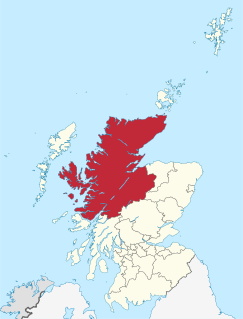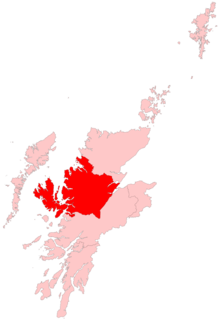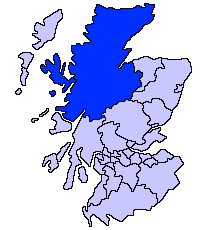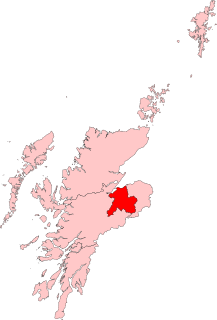
Highland is a council area in the Scottish Highlands and is the largest local government area in the United Kingdom. It was the 7th most populous council area in Scotland at the 2011 census. It shares borders with the council areas of Aberdeenshire, Argyll and Bute, Moray and Perth and Kinross. Their councils, and those of Angus and Stirling, also have areas of the Scottish Highlands within their administrative boundaries.

Caithness, Sutherland and Easter Ross is a constituency of the House of Commons of the Parliament of the United Kingdom (Westminster). It is the most northerly constituency on the British mainland. It elects one Member of Parliament (MP) by the first-past-the-post system of election.

Caithness and Sutherland was a county constituency of the House of Commons of the Parliament of the United Kingdom from 1918 to 1997. It elected one Member of Parliament (MP) by the first past the post system of election.

Inverness, Nairn, Badenoch and Strathspey is a constituency of the House of Commons of the UK Parliament. As with all seats since 1955 it elects one Member of Parliament (MP) by the first past the post system of election.

Ross, Skye and Lochaber is a constituency of the House of Commons of the Parliament of the United Kingdom (Westminster). It elects one Member of Parliament (MP) by the first past the post system of election.

Caithness, Sutherland and Easter Ross was a constituency of the Scottish Parliament (Holyrood), in use between 1999 and 2011. It elected one Member of the Scottish Parliament (MSP) by the first past the post method of election. Also, however, it was one of eight constituencies in the Highlands and Islands electoral region, which elects seven additional members, in addition to eight constituency MSPs, to produce a form of proportional representation for the region as a whole.

Ross, Skye and Inverness West was a constituency of the Scottish Parliament (Holyrood). It elected one Member of the Scottish Parliament (MSP) by the first past the post method of election. Also, however, it is one of eight constituencies in the Highlands and Islands electoral region, which elects seven additional members, in addition to eight constituency MSPs, to produce a form of proportional representation for the region as a whole.
Ross, Cromarty and Skye was a constituency of the House of Commons of the Parliament of the United Kingdom from 1983 to 1997. The constituency elected one Member of Parliament (MP) by the first-past-the-post system of election.

Ross, Skye and Inverness West was a constituency of the House of Commons of the Parliament of the United Kingdom from 1997 to 2005. The constituency elected one Member of Parliament (MP) by the first-past-the-post system of election.

Inverness East, Nairn and Lochaber was a constituency of the Scottish Parliament (Holyrood). It elected one Member of the Scottish Parliament (MSP) by the first past the post method of election. It was one of eight constituencies in the Highlands and Islands electoral region, which elects seven additional members, in addition to constituency MSPs, to produce a form of proportional representation for the region as a whole.
Inverness East, Nairn and Lochaber, was a county constituency of the House of Commons of the Parliament of the United Kingdom from 1997 to 2005. It elected one Member of Parliament (MP) by the first-past-the-post system of election.

Na h-Eileanan an Iar, formerly the Western Isles, is a constituency of the Scottish Parliament (Holyrood) covering the council area of Na h-Eileanan Siar. It elects one Member of the Scottish Parliament (MSP) by the first past the post method of election. It is also one of eight constituencies in the Highlands and Islands electoral region, which elects seven additional members, in addition to the eight constituency MSPs, to produce a form of proportional representation for the region as a whole.
Inverness was a county constituency of the House of Commons of the Parliament of the United Kingdom from 1918 until 1983. It elected one Member of Parliament (MP) by the first-past-the-post system of election.

The politics of the Highland council area in Scotland are evident in the deliberations and decisions of the Highland Council, in elections to the council, and in elections to the House of Commons of the Parliament of the United Kingdom (Westminster) and the Scottish Parliament (Holyrood). In the European Parliament the area was within the Scotland constituency, which covers all of the 32 council areas of Scotland.

The third set of Highland Council wards, 22 in number, became effective for election purposes in 2007, for the fourth general election of the Highland Council. The new wards were created under the Local Governance (Scotland) Act 2004, and are as defined in recommendations of the Local Government Boundary Commission for Scotland.

The Highland Council, the political body covering the Highland local authority created in 1995, comprises 21 wards, each electing three or four councillors by the single transferable vote system, which creates a form of proportional representation. The total number of councillors is 74, and the main meeting place and main offices are in Glenurquhart Road, Inverness.

Caithness, Sutherland and Ross is a constituency of the Scottish Parliament covering the northern part of the Highland council area. It elects one Member of the Scottish Parliament (MSP) by the first past the post method of election. It is also one of eight constituencies in the Highlands and Islands electoral region, which elects seven additional members, in addition to eight constituency MSPs, to produce a form of proportional representation for the region as a whole.

Inverness and Nairn is a constituency of the Scottish Parliament (Holyrood) covering part of the Highland council area. It elects one Member of the Scottish Parliament (MSP) by the first past the post method of election. It is also one of eight constituencies in the Highlands and Islands electoral region, which elects seven additional members, to produce a form of proportional representation for the region as a whole.

Skye, Lochaber and Badenoch is a constituency of the Scottish Parliament (Holyrood) covering part of the Highland council area. It elects one Member of the Scottish Parliament (MSP) by the first past the post method of election. It is also one of eight constituencies in the Highlands and Islands electoral region, which elects seven additional members, as well as eight constituency MSPs, to produce a form of proportional representation for the region as a whole.

The fifth set of Highland Council wards, 21 in number, became effective for election purposes in 2017, for the fifth general election of the Highland Council. The new wards were created under the Local Governance (Scotland) Act 2004, and are as defined in recommendations of the Local Government Boundary Commission for Scotland. The commission's report includes maps of the new wards
Generally, descriptions above are inferred from the maps.
















